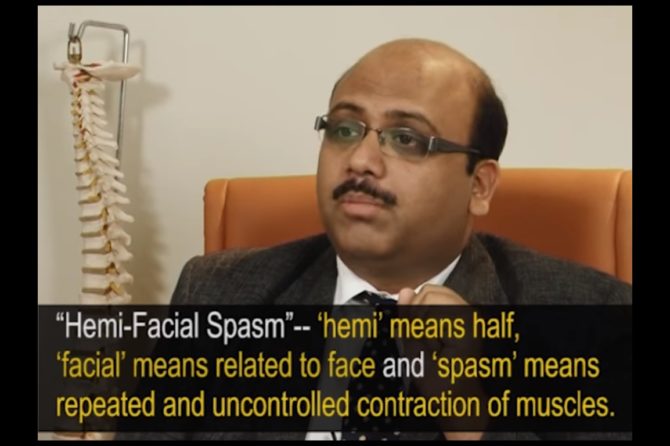
Hemifacial Symptoms
Interviewer:
Namaste! What is Hemifacial Spasm? What are the symptoms of this disease? All these questions are answered by Dr Jaydev Panchawagh, who is a renowned neurosurgeon from Pune, Maharashtra, India.
Dr Jaydev Panchwagh:
Let me explain what the word Hemifacial spasm means . Hemi means half, facial means related to the face, and spasm means repeated and uncontrolled contraction of the muscles.
In this disease, patients suffer from contraction of one side of the face, which they are not able to control. So when such afflicted persons begin a conversation, contraction of one side of the face occurs , which results in winking of the eye on that side of the face. It may appear to the observer that the person is winking their eye! Initially, the eye and only a part of the face contracts involuntarily, and as the disease progresses the entire half of the face may get pulled to one side. Generally, these symptoms initially begin when the patient is stressed or is in a conversation. Later, it occurs randomly, at any time.
For example, a student who has gone for an interview and is under stress to perform well could manifest these symptoms of Hemifacial spasm. Or a secretary in a company dealing with a new client could have enhanced stress levels which trigger the hemifacial spasm.
In fact, any occasion which causes stress to a person where they become conscious of their facial expressions like social interaction could trigger Hemifacial spasms.
This is a socially troublesome disease. The patient feels very awkward talking to others and tries to avoid face-to-face interaction. They start avoiding social contacts and their professional life may also suffer. Others may not understand why the patient speaks peculiarly. Over a period of time, the patient becomes self-conscious and starts avoiding social interactiions. This may affect his personality as well, and there is a danger of losing one’s job due to this.
Interviewer:
Doctor, what causes this disease?
Dr Jaydev Panchwagh:
The facial nerve controls the movements of our facial muscles as well as our facial expressions. If the facial nerve gets irritated due to some reason, or is compressed either continuously or in a pulsatile manner, then it fires repeatedly sending signals to the muscles to contract. After all, what is a nerve? It can be compared to an electrical wire which carries the current of command/ control signals from the brain to the muscles. So, when the facial nerve conducts information from the brain, it makes the muscles of the face contract. If the facial nerve is provoked to fire repeatedly and unwarrantedly, due to whatever reason, the facial muscles on the same side begin to twitch on their own and the patient has no control over it.
In a tense or stressful situation, or during a social interaction, the nerve triggers signals and the facial twitching gets exacerbated. Though the main cause is likely to be a blood vessel that compresses the nerve, occasionally there could be a tumour which causes compression and symptoms of hemifacial spasm. This is not common…I would say about 3 or 4 cases out of 100. Different studies would give different numbers, but this is a generalisation. 96-97 % of Hemifacial spasm is likely to be caused by a blood vessel compressing the facial nerve at its origin, near the brain stem.
Initially the spasms are less intense and more focused around the eye muscles and are less frequent. As the compression on the facial nerve progresses, the nerves ‘weaken’ because of constant pulsation. Going back to the analogy of a nerve being like an electrical wire or cable, the nerve fibres are very close to each other like wires in an electric cable. Individual wires are separated from each other by insulation. The equivalent of insulation in the nerve is called myelin sheath. In hemifacial spasm, when there is compression by the blood vessel, the myelin sheath is lost or damaged. This causes the individual wires or nerve fibres to talk to each other, called ‘cross-talk’. This is like a short-circuit in the electric wire caused by lack of insulation. The longer the compression exists, the greater is the loss of myelin and greater is the cross-talk. The symptoms worsen, the disease progresses and the recovery become more unpredictable. Typically it takes about 6 to 7 years for the symptoms to worsen and involve one half of the face.
Leave a reply
Leave a reply